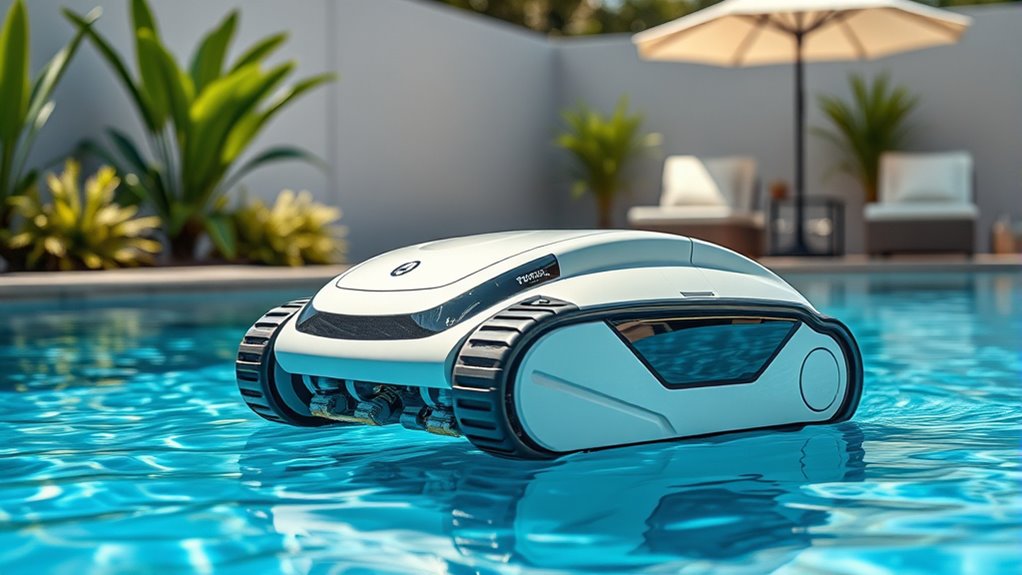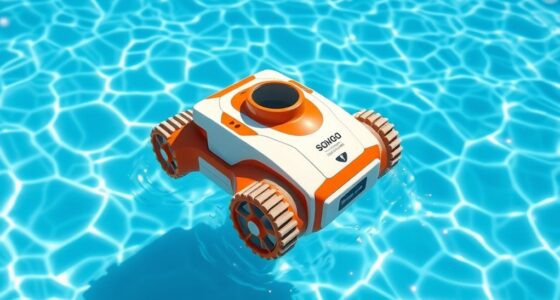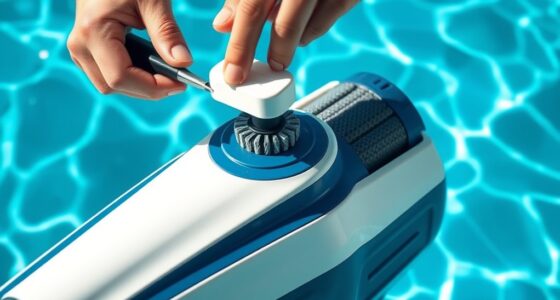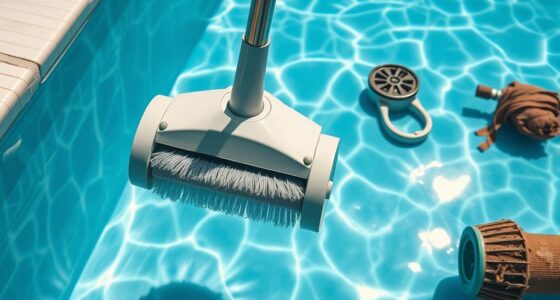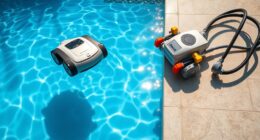Robotic pool cleaners have evolved from luxury gadgets into essential household tools thanks to technological advances like smarter navigation, wireless connectivity, and affordable designs. Early models struggled with limited cleaning power and navigation, but innovations in sensors, AI, and battery life now deliver efficient, automated cleaning. As costs drop and features improve, more households see these devices as everyday essentials. To discover how this shift continues to unfold and what’s next, keep exploring this fascinating evolution.
Key Takeaways
- Early robotic pool cleaners focused solely on basic cleaning, with limited navigation and manual supervision requirements.
- Technological breakthroughs like advanced sensors, AI, and connectivity improved efficiency, affordability, and user convenience.
- Falling manufacturing costs made robotic cleaners accessible to a broader consumer base, shifting from luxury to household essential.
- Modern features such as app control, smart mapping, and voice commands meet increasing consumer expectations for ease and effectiveness.
- Future innovations in battery life, eco-friendly design, and smart integration will further cement robotic pool cleaners as indispensable household tools.
The Origins of Robotic Pool Technology
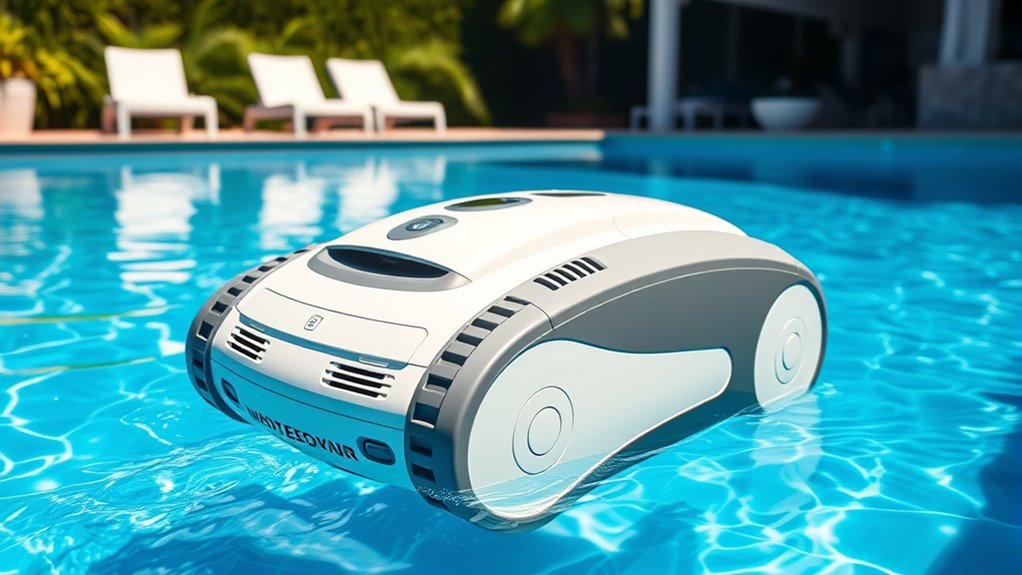
The development of robotic pool technology began with the desire to simplify pool maintenance and reduce manual labor. Early efforts focused on automating tasks that once required constant manual operation, like scrubbing floors and walls. These early devices aimed to make upkeep easier, but they didn’t yet address the importance of maintaining proper pool chemistry. Manual operation often meant frequent testing and chemical adjustments to keep water balanced, which was time-consuming. As technology advanced, engineers sought solutions that could handle cleaning and assist with chemical management more efficiently. This desire to improve pool care set the foundation for modern robotic cleaners, transforming them from simple gadgets into essential tools that help maintain both cleanliness and ideal pool chemistry. Establishing a clear financial timeline can also help pool owners budget effectively for ongoing maintenance and upgrades.
Early Models and Their Limitations
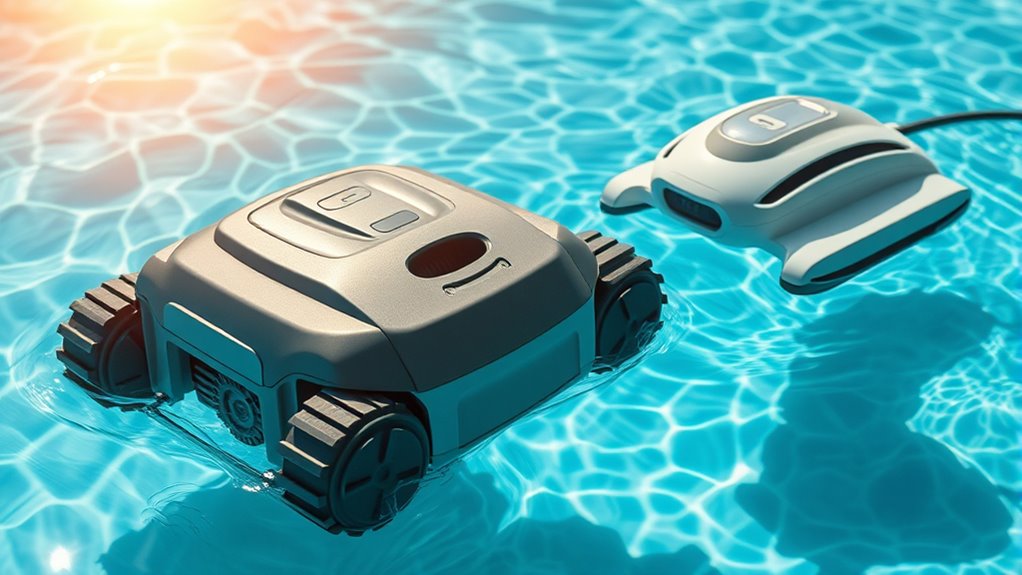
Early robotic pool cleaners could only handle basic cleaning tasks and often missed spots. Their navigation skills were limited, causing them to get stuck or miss areas of the pool. Plus, they required frequent maintenance, making them less convenient and more costly to operate. Improvements in navigation systems have since allowed modern models to clean more efficiently and reliably. Additionally, newer designs incorporate advanced sensors that enable better obstacle detection and path planning, further enhancing their effectiveness. The development of tuning technologies in their motors and components has also contributed to their increased efficiency and user-friendliness.
Basic Cleaning Capabilities
Although they marked a significant step forward, early robotic pool cleaners often struggled with basic cleaning tasks. Their limited battery life meant you had to supervise multiple cycles, which disrupted your routine. The cleaning speed was slow, leaving spots untouched and prolonging the process. These models could only handle surface debris and lacked the power to scrub stubborn dirt.
| Battery Life | Cleaning Speed | Effectiveness |
|---|---|---|
| Short, often less than 1 hour | Slow, needing hours to clean | Inconsistent, missed spots |
| Limited runtime | Frustrating pace | Incomplete cleaning |
| Frequent recharges needed | Longer cleaning times | Less reliable |
| Restricted performance | Reduced efficiency | Customer dissatisfaction |
Limited Navigation Skills
Despite their advancements in cleaning mechanics, early robotic pool cleaners struggled considerably with navigation. They faced significant navigation challenges that limited their efficiency. These models lacked sophisticated sensors, making obstacle avoidance difficult. As a result, they often got stuck on pool steps, ladders, or uneven surfaces. Their limited ability to map the pool meant they missed spots and wasted time rerouting. You’d find yourself supervising their work or manually repositioning them to cover the entire area. The inability to effectively navigate made these early models less reliable and frustrating to use. Overcoming navigation challenges was essential for improving their performance. This limitation highlighted the need for better sensors and smarter programming, paving the way for future innovations in robotic pool cleaner technology. Ethical Hacking techniques are also used to identify vulnerabilities in these systems, ensuring they operate securely.
High Maintenance Needs
Limited navigation skills in initial robotic pool cleaners often led to increased maintenance needs. These early models struggled to cover the entire pool efficiently, causing frequent jams and missed spots, which heightened maintenance challenges. Durability issues also plagued these units, as their components weren’t built to withstand constant exposure to pool chemicals and water pressure. You might have found yourself cleaning or repairing parts more often than expected, which added to the overall upkeep. Additionally, the lack of advanced navigation technology in these models meant that they could not effectively address issues like algae buildup or uneven cleaning, further increasing their maintenance demands. The absence of smart features and adaptive cleaning patterns meant that early models could not optimize their performance, leading to more frequent manual intervention. These limitations meant that early robotic cleaners required regular attention to keep them functioning properly. As technology progressed, manufacturers incorporated smart features and improved navigation systems, significantly reducing the maintenance challenges and making robotic pool cleaners more reliable and user-friendly. Moreover, the introduction of durable components designed to resist corrosion and wear greatly enhanced their lifespan and reduced repair frequency. Additionally, improvements in water-resistant materials have helped prevent corrosion and extend the longevity of these devices.
Technological Breakthroughs and Innovations
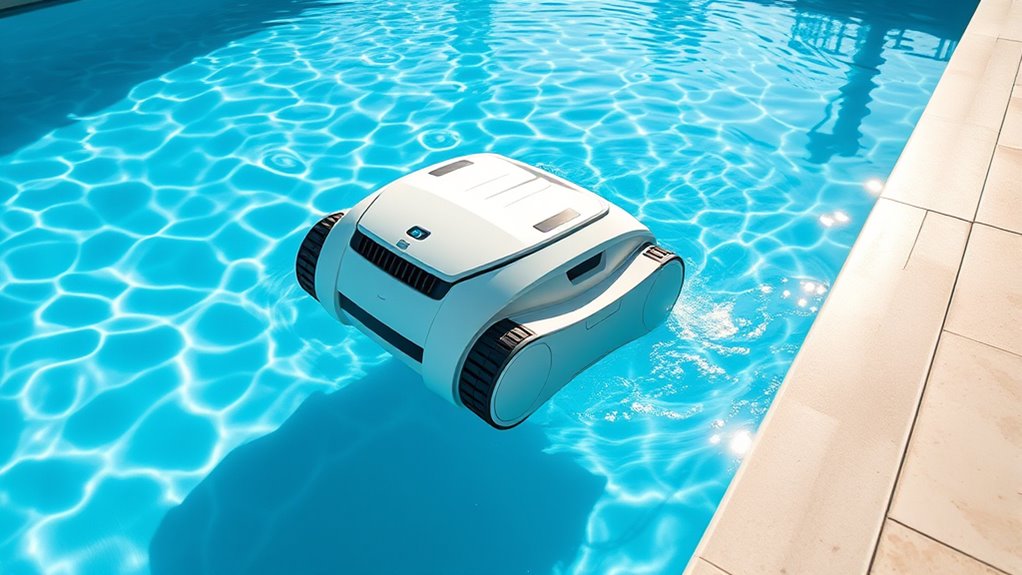
Recent technological breakthroughs have dramatically transformed robotic pool cleaners, making them more efficient, intelligent, and user-friendly. Enhanced sensor accuracy allows your cleaner to navigate pools with precision, avoiding obstacles and ensuring thorough cleaning. Improvements in battery longevity mean longer operation times between charges, so you spend less time waiting and more time enjoying your pool. These innovations also include smarter mapping systems that optimize cleaning routes and faster, more responsive motors for better scrubbing power. Additionally, advancements in waterproofing and wireless connectivity provide seamless control via smartphone apps. You’ll find that these breakthroughs enable your robotic cleaner to perform more effectively, saving you effort and providing a consistently pristine pool with minimal maintenance. Airless paint sprayers are also benefiting from similar technological progress, offering more precise application and greater versatility. Incorporating advanced sensor technology further enhances the cleaner’s ability to adapt to various pool shapes and sizes, ensuring comprehensive coverage with less manual intervention. Moreover, ongoing research into AI security helps developers create smarter systems that can better detect and respond to potential malfunctions or vulnerabilities, ultimately increasing trustworthiness and safety. Additionally, the integration of machine learning algorithms allows these devices to improve their performance over time based on usage patterns. Furthermore, increased adoption of cloud computing facilitates real-time updates and remote diagnostics, enhancing overall device management.
The Role of Cost Reduction and Market Expansion
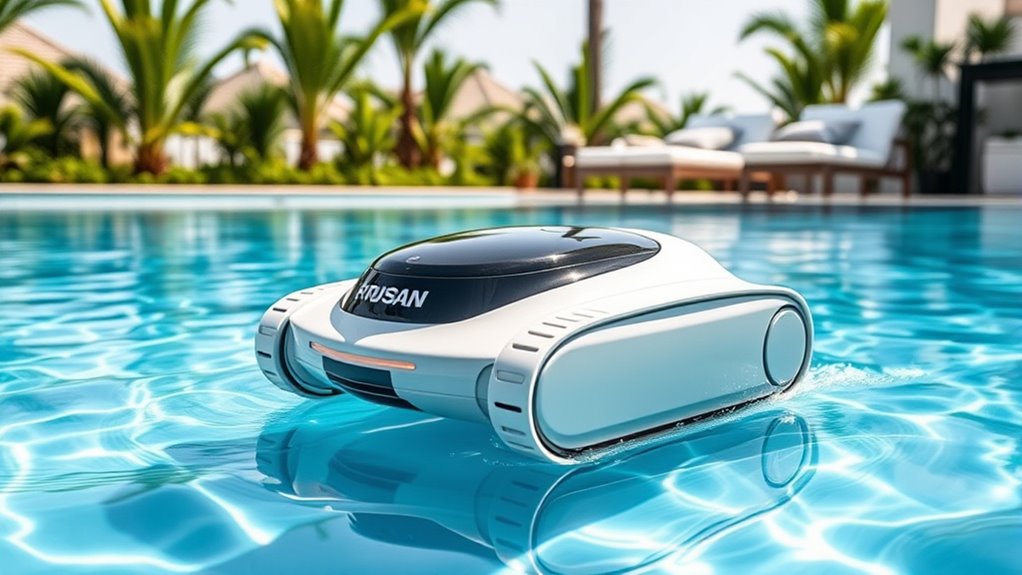
When costs decrease, more homeowners can afford robotic pool cleaners, making them accessible to a wider audience. This affordability encourages manufacturers to develop innovative features without raising prices. As a result, market expansion accelerates, bringing these cleaning solutions into more households. Additionally, the integration of home decor aesthetics into robotic pool cleaners, such as customizable colors and sleek designs, appeals to consumers seeking both functionality and style. The increasing availability of affordable options further drives adoption among budget-conscious buyers. Recognizing the importance of understanding customer needs, manufacturers often incorporate personality insights to tailor features that resonate with diverse consumer preferences.
Affordable Innovation Drives Adoption
Affordable innovation plays an essential role in expanding the popularity of robotic pool cleaners by making advanced technology accessible to more consumers. As costs decrease, you can perform a cost benefit analysis that shows long-term savings compared to traditional cleaning methods. Lower prices also reduce the environmental impact by decreasing energy consumption and waste. This broadens market appeal, encouraging more people to invest in automation. Key factors include:
- Reduced manufacturing costs enabling lower retail prices
- Increased competition driving innovation and affordability
- Improved energy efficiency aligning with eco-conscious choices
- Enhanced accessibility for a wider range of budgets
- Incorporating Mazda Tuning principles can inspire smarter, more efficient designs that further reduce costs and improve performance. Emphasizing cost-effective design can lead to more sustainable and user-friendly products. Additionally, leveraging market expansion strategies can accelerate adoption across diverse consumer segments.
Broader Market Accessibility
As manufacturing costs drop, robotic pool cleaners become accessible to a broader audience, expanding the market beyond early adopters. Lower prices increase market penetration, making these devices affordable for more homeowners. As consumer awareness grows, more people recognize the convenience and efficiency robotic cleaners offer, fueling demand. Manufacturers respond by developing a wider range of models that cater to different budgets and needs, further widening access. This cost reduction fosters confidence in the technology, encouraging new users to try robotic pool cleaners. Additionally, as the technology becomes more prevalent, the maintenance requirements for these devices are better understood, leading to enhanced performance and longevity. As a result, the market shifts from niche luxury to mainstream necessity. Your increased awareness and affordability options help accelerate this progression, ensuring robotic pool cleaners become a common feature in many households.
Modern Features and Smart Integration
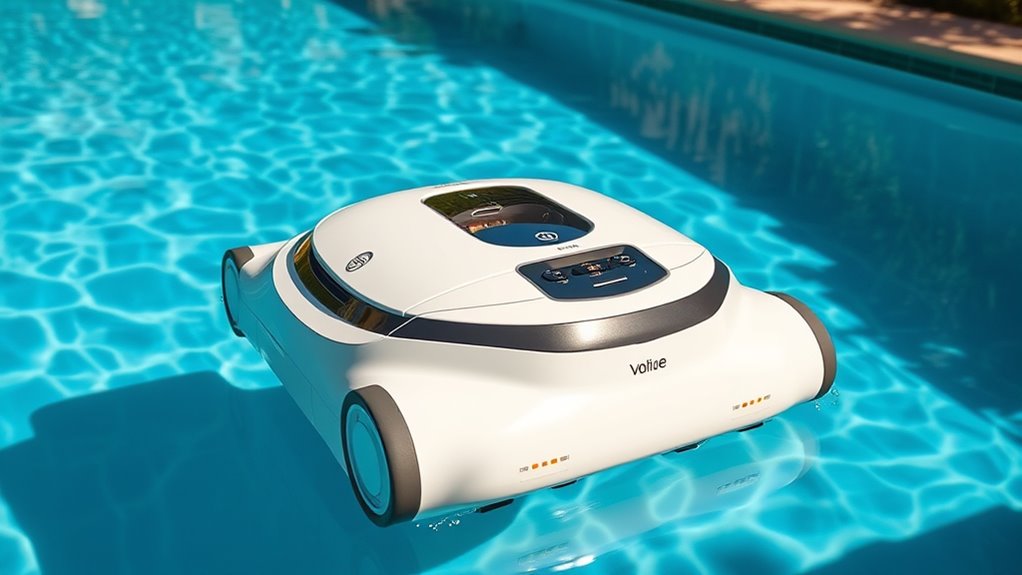
Modern robotic pool cleaners are equipped with advanced features that make maintenance effortless and efficient. You can control and customize your cleaner easily with voice control, allowing you to start or pause cleaning with simple commands. App integration lets you monitor your pool remotely, set cleaning schedules, and receive updates directly on your smartphone. Many models also include smart mapping, which optimizes cleaning paths for maximum coverage. Some feature sensors that detect debris buildup or obstacles, adjusting their route accordingly. Additionally, Wi-Fi connectivity enables seamless updates and integration with smart home systems. These innovative features are often influenced by family dynamics, which play a role in the development of consumer technology trends. As automation technology continues to evolve, it is increasingly capable of scaling operations to meet diverse user needs. With these features, maintaining your pool becomes more convenient, giving you more free time to enjoy your backyard oasis.
Consumer Adoption and Changing Expectations
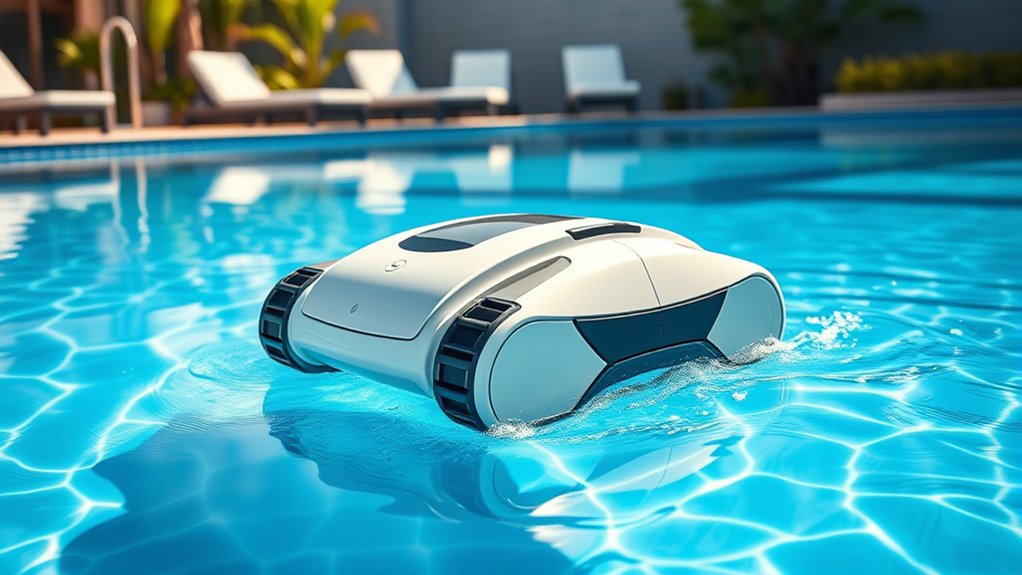
Consumers are increasingly embracing robotic pool cleaners, driven by their desire for convenience and efficiency. However, consumer skepticism about new technology still exists, especially regarding durability and performance. Many users initially question whether these devices can meet their expectations or replace traditional cleaning methods. As trust builds through positive experiences, brand loyalty grows, making customers more likely to stick with reliable brands. Changing expectations now prioritize not only effective cleaning but also smart features, energy efficiency, and ease of use. This shift reflects a broader trend of consumers demanding more value from their investments. Ultimately, overcoming skepticism and aligning with evolving needs are key to widespread adoption, transforming robotic pool cleaners from luxury gadgets into essential household tools.
Future Trends and Continuing Evolution
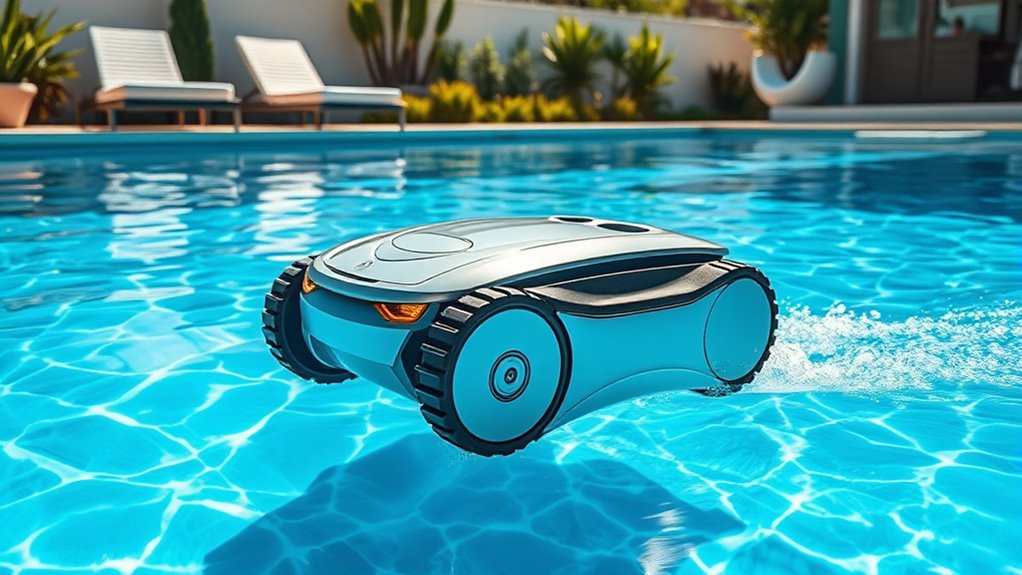
Looking ahead, the future of robotic pool cleaners is poised for rapid innovation driven by advancements in artificial intelligence, sensor technology, and connectivity. Expect cleaners to become smarter, more efficient, and eco-friendly. They’ll feature improved battery technology, enabling longer cleaning cycles and faster recharging times. Eco-friendly designs will emphasize sustainable materials and energy efficiency, reducing environmental impact. Connectivity will allow you to control and monitor your cleaner remotely via smartphone apps, offering real-time updates and customizable schedules. Additionally, sensors will enhance navigation, ensuring thorough cleaning even in complex pool shapes. You might also see solar-powered models or units with biodegradable components. This evolution will make robotic pool cleaners even more integral to pool maintenance, blending convenience, sustainability, and cutting-edge technology seamlessly.
Frequently Asked Questions
How Do Robotic Pool Cleaners Compare to Traditional Manual Cleaning Methods?
You’ll find robotic pool cleaners outperform manual effort in cleaning efficiency, saving you time and energy. Unlike manual methods, they automatically scrub and vacuum your pool, reaching every corner. This means less gritty work for you and a cleaner pool overall. You won’t have to spend hours with a brush or hose, and your pool stays pristine with minimal effort, making robotic cleaners a smart, modern choice.
What Environmental Impacts Do Robotic Pool Cleaners Have?
You might not realize it, but robotic pool cleaners can profoundly reduce environmental impacts. They use less energy than traditional methods, lowering energy consumption and cutting down on electricity bills. Plus, because they clean more efficiently, there’s less chemical runoff into your pool and surrounding environment. This means fewer harmful chemicals leach into the water, making your pool maintenance more eco-friendly and sustainable, protecting your backyard and beyond.
Are Robotic Pool Cleaners Effective in All Types of Pool Surfaces?
You might wonder if robotic pool cleaners work on all pool surfaces. Generally, their cleaning effectiveness depends on pool surface compatibility. Most models efficiently clean concrete, vinyl, and tiled surfaces, but some may struggle with delicate materials like fiberglass or pebble finishes. To guarantee ideal cleaning, choose a robotic cleaner designed for your specific pool surface. Proper selection guarantees better results and extends the device’s lifespan.
How Do Maintenance Requirements Vary Among Different Models?
You’ll find that maintenance requirements differ among models. Some need frequent filter maintenance to keep cleaning efficiency high, while others have advanced filters that last longer. Battery life varies too; higher-end models often offer longer runtime with quick recharge features. Consider how often you’ll need to clean or replace filters and how long the robot can operate in one session, so you choose a model that fits your pool maintenance routine.
What Are the Cybersecurity Concerns Related to Smart Robotic Pool Cleaners?
Cybersecurity concerns cluster around your smart robotic pool cleaner’s data privacy and hacking vulnerabilities. You should be wary of potential breaches that could expose personal data or allow malicious access. Protect your device with robust passwords, keep firmware updated, and avoid unsecured networks. Vigilance helps prevent hackers from exploiting vulnerabilities, ensuring your pool cleaner remains a safe, secure, and seamless part of your smart home ecosystem.
Conclusion
Just as the tide reshapes the shoreline, robotic pool cleaners have transformed from luxury gadgets into essential tools. With every innovation, they’ve become more intuitive and reliable, seamlessly blending into your backyard oasis. As technology continues to advance, you can imagine these devices evolving into silent guardians, tirelessly maintaining your pool’s clarity. Embrace this evolution, and soon, your pool will be as effortless to enjoy as a gentle breeze—an everyday luxury turned necessity.
